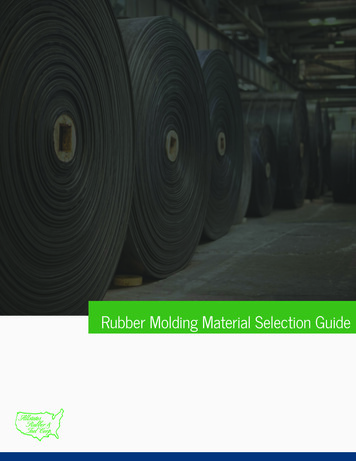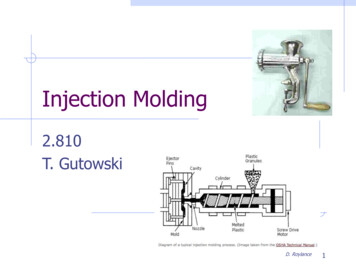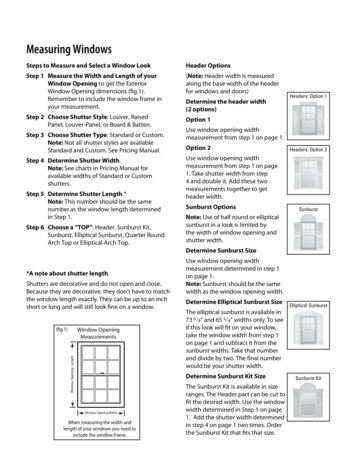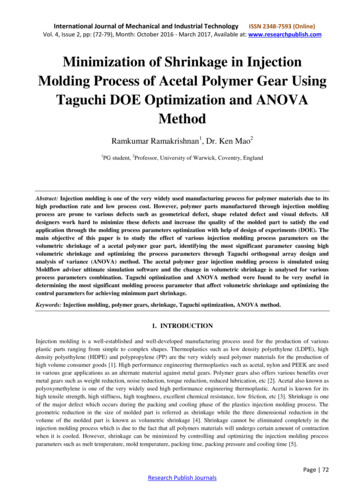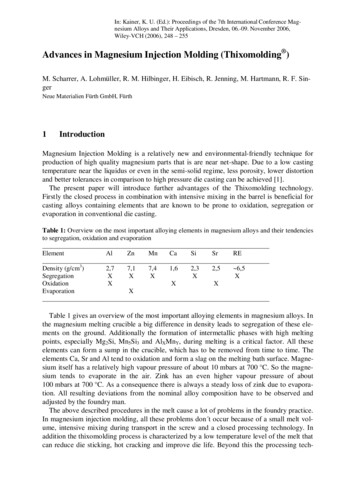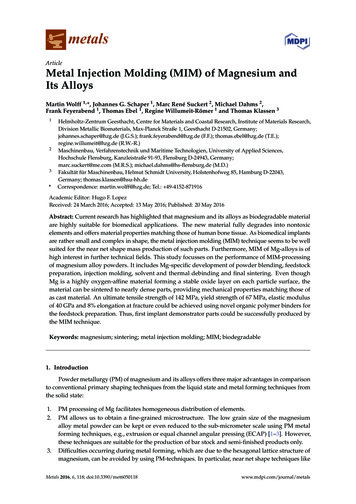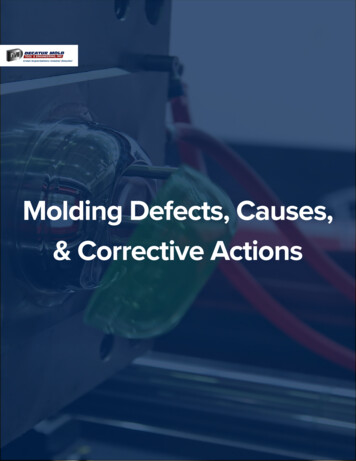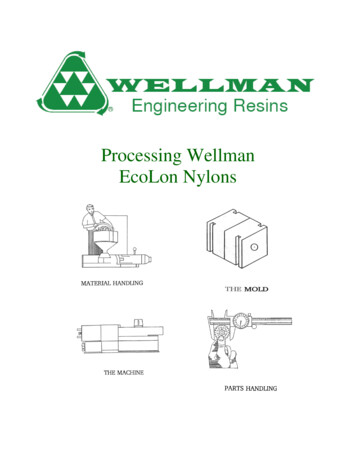
Transcription
Processing WellmanEcoLon Nylons
Contents1. Material Handling- Nylon Characteristics . . . .5- Absorption of Moisture. . . 8- Drying . 92. Injection Molding Machine- Machine Recommendations . .13- Barrel Temperature Profiles . . .16- Measuring Melt Temperature . . 17- Molding Conditions . . . 18- Trouble Shooting Guide . . . 22- Purging and Shut Down . . . 253. Molds- Mold Temperature . . . 27- Gates . 28- Runners . 30- Venting . 31- Mold Shrinkage 324. Parts Handling- Dimensional Stability . 34- Post Molding Environments . 37- Regrind . 382
PrefaceThis guide is included to give basic recommendations on the use ofWellman EcoLon nylon resins in the injection-molding environment.Wellman with its comprehensive resources is ready to share itsaccumulated knowledge with their customers. This guide will identifythe fundamental areas of the injection molding environment. We hopeit will be useful in obtaining optimum results when using WellmanEcoLon nylons.Because of the fallibility of all the elements involved, we are strongproponents of prototype usage before committing to production design.All recommendations are based on good faith effort to assist in yourapplication, they are, however, only recommendations. Therefore, theinformation in this document is provided "as is" without warranty ofany kind, either expressed or implied, for fitness of use.WELLMANEngineering Resins Division520 Kingsburg HighwayJohnsonville, SC. 295551-800-821-6022Revised on July 29, 20143
Base resin overview .5Absorption of moisture 8Drying . 94
BASE RESINS OVERVIEWNylon is a member of the thermoplastic polyamide (PA) family, and is considered to bethe first crystalline plastic. It was invented way back in the 1930's but introduced forinjection molding around 1943.Largest selling commercial types:NYLON 66Derived from hexamethylene diamine and adipic acid.Melt point of 260 C (500 F).The generic formula is:H2N (CH2) 6 NH2 HOOC (CH2) 4 COOH H (HN(CH2)6 NHCO(CH2)4CO) OH H2ONYLON 6Derived from caprolactam.Melt point of 220 C (430 F).The generic formula is:CH2/\CH2C0 H2 0 CH2NH H (NH(CH2 )5CO) OHCH2 —— CH2Nylons are among the toughest of all thermoplastics with excellent chemical, abrasionand creep resistance. This, together with high tensile strength, rigidity and heat distortiontemperatures, makes nylon a very popular, cost effective, engineering resin.All nylon compositions have certain molding advantages:- Fast overall cycle times.- Good weld strength.- Good flow characteristics and toughness in thin sections.5
BASE RESINS OVERVIEWAMORPHOUS VS CRYSTALLINEMost all of today's thermoplastics can be lumped into these two categories. There are,however, very distinct differences between the two as follows:CRYSTALLINE polymers have a very dense "ordered" structure, in which the moleculesin certain regions get tightly aligned. As heat is added, they remain solid until they reachtheir sharp melting point, then all crystalline structure is destroyed and they become avery easy flowing liquid like substance. Crystalline polymers include; nylon, PBT, PET,polypropylene and polyethylene.AMORPHOUS polymers don't really melt. Instead, they have a broad softening range.The molecular structure is more like random coils or "spaghetti like." Very stiff flowingat low temperatures, but as heat is increased, space is added between the moleculesmaking it more easily flowing. Amorphous polymers include; ABS, acrylics, styrene andpolycarbonates.Figure 1.16
BASE RESINS OVERVIEWCRYSTALLINITYThe morphological structure of both nylon 66 and nylon 6 is actually semicrystalline. Ifyou were to observe both through a microscope, two separate and distinct phases wouldbe revealed: an ordered crystalline phase and a random amorphous phase. This couldappear like crystalline islands surrounded by an amorphous sea (Figure 1.2).Processing can greatly effect the level of crystallinity in molded parts because the moreslowly a melt of crystalline nylon is allowed to cool, the greater the degree of "asmolded" crystallinity.Figure 1.2 CrystallinitySlower cooling promotes crystal formation.Increased crystallinity means:-Greater initial shrinkageLess chance for additional shrinkageIncreased dimensional stabilityBetter chemical resistanceIncreased heat deflection temperature (HDT)7
HANDLING OF WELLMAN ECOLON NYLONSAbsorption of MoistureNylons exposed to the atmosphere for even short periods of time willabsorb moisture from the air and will become impossible to moldsuccessfully. As supplied, Wellman EcoLon nylons are dry and readyfor molding. To ensure that the material remains dry, these proceduresare recommended:1)Do not allow nylon to be exposed to the atmosphere.2)Before the nylon container is opened, allow the resin to reachroom temperature.3)Wellman EcoLon nylons sold in bags can be resealed using aheat-sealing iron.4)If moisture level problems persist, the use of a dehumidifyingdryer should be considered. Dehumidifying dryers are discussedlater.Moisture Absorptionof EcoLon Pelletsmoisture content %1.31.10.90.70.50.30.1024673F exposure81012hours50% RH75% RH144100% RH8
Dryer RecommendationsWellman EcoLon nylons are shipped dry and are ready for molding.However, like many other engineering polymers, nylons have a greataffinity for water. Unless care is taken, the moisture level of nylonswill quickly rise and processing characteristics suffer. The use ofregrind can also introduce nylon of unknown moisture levels to thenylon feedstock stream. For many processing facilities, the use ofdehumidifying hopper dryers has proven to be effective in the control ofnylon moisture levels.Wellman recommends the use of dehumidifying desiccant bed hopperdryers. Hot air dryers of any design are not recommended. Like otherengineering polymers, such as polyesters and polycarbonates, nylonsare hygroscopic. Hygroscopic materials absorb moisture from theatmosphere. Non-hygroscopic materials such as polystyrene andpolypropylene require only surface moisture removal; hygroscopicmaterials require removal of moisture from within the pellet. Becauseof this difference, non-hygroscopic materials can use hot air dryers to"blow off" moisture from the surface while dehumidifying dryers areneeded to dry hygroscopic materials in order to "wring out" moisturefrom within.Desiccant bed hopper dryers consist of a filter(s), a blower, adehumidifier or desiccant bed, a heater and a hopper. The dryingprocess consists of a cycle that begins when the desiccant bed trapsmoisture from the air. This dry air is heated and blown to the hopper.Moisture from the polymer is attracted to the dry air and is taken backto the desiccant bed to begin the process again. Many dehumidifyingdryers possess at least two desiccant beds. One is being used to dry theair while the other is being regenerated. This regeneration is theremoval of the moisture from the desiccant crystals to the atmosphere.This enables the dehumidifying dryer to be used continuously.9
Time Required to Dry NylonThe time required to dry nylon largely depends upon these majorfactors:1. The relative humidity of the drying atmosphere. This is oftendescribed as dew point*, and many dehumidifying dryers use dewpoint meters to convey this information.2. The temperature of the drying air. Higher air temperatures increasethe rate of drying. There are limits; prolonged exposure of nylon totemperatures in excess of 95 C (200 F) may discolor the nylon. 70to 85 C (160 to 180 F) drying temperatures are recommended.3. The air flow rate of the dehumidified air. This is generally fixed bythe dryer manufacturer. Higher air flow rates increase dryerefficiency.4. The initial moisture level of the nylon to be dried. The higher themoisture level the longer the drying cycle. Freshly opened bags willrequire little to no drying, while exposed nylons require muchlonger.Typical drying times for Wellman EcoLon nylons:2–4 hours at 170 F with dryer dew point –20 to –40 FNote of caution: Though nylons are hygroscopic and require moisturelevels below 0.25% to be successfully molded, very low moisturecontent ( 0.05%) can reduce flow characteristics. This may becharacterized by poor fill characteristics in difficult to fill molds, i.e.short shots. Optimal moisture levels range between 0.10 to 0.18% byweight. For those applications that are moisture sensitive and for whichmoisture level determination is required, there are a number ofmanufacturers who produce moisture level testing machines.* Dew point is the temperature in which the air must be cooled for thewater vapor to condense, i.e. the lower the dew point the dryer the air.10
Dryer MaintenanceThe successful drying of nylon depends upon the working order of thedryer. Improperly maintained dryers will quickly lose their ability toremove moisture from nylon. Taken to the extreme, malfunctioningdryers have proven to be effective in adding moisture to nylon. Asimple preventative maintenance program will be effective in keepingdrying equipment in good working order.Filters - Improperly maintained filters are the primary cause of dryerfailure. Dirty filters can lead to desiccant beds that are contaminatedwith fines, dust or dirt, and will severely inhibit the desiccant bed fromattracting moisture. Dirty filters will also slow the drying process byreducing dry air through-put. Filters should be checked daily and willgenerally require servicing on a weekly basis.Desiccant Beds - Due to the constant wetting and drying process, thedesiccant bed will gradually lose their ability to absorb moisture.Desiccant beds do not last forever and will eventually requirereplacement. How long depends on the number of machine hours andits freedom from fines, dirt, etc. Two years of service life is the typicallimit.11
Machine recommendations . . 13Barrel temperature profiles . 16Measuring melt temperature 17Molding conditions . 18Trouble shooting guide 22Purging and shut down 2512
INJECTION MOLDING MACHINEWellman EcoLon nylons are specifically designed for use in screwtype injection molding machines. This section is devoted to identifyingkey injection molding machine characteristics that are important to thesuccessful molding of Wellman EcoLon nylons.Shot Size CapacityShot size is the volume of material (by weight) that a given machinewill deliver in a single shot. Since polymers differ in density machinemanufacturers publish shot size capacity in terms of polystyrene. If amachine's rated polystyrene shot size capacity is known it is possible toaccurately estimate the shot weight of any other polymer by relatingtheir respective densities. In the case of nylon, polystyrene has a nearequal melt density. Hence, the maximum shot size of unfilled nylons isapproximately equal to the shot size capacity given in polystyrene. Thetable listed below gives details for filled nylons, which are higher indensity than polystyrene.Material type13% Glass Fill33% Glass Fill43% Glass Fill40% Mineral Fill% Greater than polystyrene10253535Clamp CapacityClamp capacity is the amount of pressure available to hold a moldclosed while polymer that is being injected under pressure is trying toforce it open.For Wellman EcoLon nylons it has been found that the clamp capacityof an injection-molding machine should provide 3 to 5 tons of clampingforce for every square inch of projected shot area. High injectionpressures may dictate the higher clamping recommendation.* Projected shot area is defined as the area of part(s) and runner(s) thatis present on the parting line of the tool.13
Screw DesignWellman recommends the use of screws designed for nylons. Mostmolding applications require high through-put rates for which thesescrews are specifically designed. In certain instances where throughput rates are not critical general purpose screws that have been suppliedby the machine manufacturer can be used successfully. Listed beloware recommendations for high output screws when using WellmanEcoLon nylons.Screw size - minimum 20:1 length/diameter ratioCompression ratio - 2.5:1 to 3.5:1Metering depth - 0.070 - 0.100 in.Feed Section - 30 to 40% of screw lengthTransition section - 30 to 40% of screw lengthMetering section - 30 to 40% of screw length14
NozzleReverse taper nozzles (some suppliers call them nylon tip nozzles) areused with greater success than ordinary general purpose tip nozzles.The major feature of a reverse taper nozzle is the taper bore, which ineffect extends the sprue into the heated nozzle. The design feature willallow lower nozzle temperatures and help to combat nozzle drool,nozzle freeze and sprue sticking.Preferred,“reversetaper”Cold slugmaydevelopNon-Return ValveNon-return valves are extremely important in the delivery of consistentshot sizes. Worn and leaking valves will be characterized by theinability to hold a cushion, inconsistent shot size and by allowingpolymer back flow, polymer degradation. The common sliding ringcheck valve that provides streamlined flow is preferred. Running glassfilled Wellman EcoLon nylons will require the use of hardened steeland, depending on throughput, will provide a useful life of 4-6 months.15
MACHINE OPERATING CONDITIONSBarrel Temperature ProfileTo optimize molding performance, it will require matching cylindertemperature profile to material requirements, machine requirements andtool requirements. For example, in high throughput conditions, barreltemperature profiles may require "hot" settings to allow sufficient heatto be conducted to the polymer. Conversely, low though-put conditionsmay require "cool" temperature settings to prevent nylon degradation.It is important to note that small changes in temperature will not yield a"perfect" heat profile. Nylons are quite forgiving and a good heatprofile will provide good processing characteristics.Wellman recommends the use of a "reverse heat profile." Higher heatsin the rear zone followed by lower heats forward. Reverse heat profilesgenerate consistent melt temperatures. For glass fiber reinforced nylonthe reverse heat profile will reduce breakage to the glass fiber andreduce wear on the screw and barrel as if conveys the material forward.The reverse heat profile (Temperature in Celsius).Material type66 unfilled66 filled6 unfilled6 filledFront265270-280260265-270Barrel temp.Center270280-295265270-280Melt 270-285The reverse heat profile (Temperature in Fahrenheit).Material type66 unfilled66 filled6 unfilled6 filledFront510520-540500510-530Barrel temp.Center520540-560510520-540Melt 520-550Screw injection machines melt nylon in two ways. Convection heat,the heat produced by the barrel temperature, and shear heat, thefrictional heat generated by the rotating screw. Shear heat is difficult tocontrol, barrel heat is not.16
Melt TemperatureIn establishing proper operating conditions one of the most importantconsiderations is the melt temperature. Incorrect melt temperaturesmay produce parts with unmelted particles of nylon being injectedwhen molded and may also contribute to poor surface finish,pronounced weld lines, flash, black specking and a host of othermaladies. Actual melt temperatures are a function of screw design,cycle times, screw speed and barrel temperature settings. While barreltemperature can give a good indication of melt temperature, it can alsomislead what is thought to be melt temperature. Barrel temperaturereadings only indicate what the temperature is of a thermal couple,which is embedded in steel somewhere near a heater band. They do notnecessarily tell you what the actual plastic melt temperature is.Measuring plastic melt temperatureIt is possible to get accurate plastic temperature readings by using ahand held pyrometer and inserting the probe into a melt pool or air shot.The following guidelines may be helpful in providing a more systematicapproach to obtaining more consistently accurate readings. Again, it isstrongly advised that good safety practices are in place when handlingmolten nylon.Procedure:-Preheat the probe of the hand held pyrometer to 20 F over theaverage of the barrel temperature settings.-Purge the machine on cycle and catch a purged shot into acontainer.-Insert preheated probe into melt center and stir for 20 seconds-and record peak temperature.17
Molding ConditionsMaterial type66 unfilled66 filled6 unfilled6 filledFront510520-540500510-530Barrel temp.( F)Center520540-560510520-540Melt temp.( -5501. Use minimum back pressure (less than 100 psi).2. Melt decompression should be minimum necessary to preventnozzle drool.3. Shot size should use most of material in barrel. We recommendusing a minimum cushion to insure packing of the cavities.4. Match screw speed to overall cycle time, nylon in barrel should bein a fairly steady state of motion.5. Injection pressure set at maximum, which just avoids flashing, holdpressure packs the part.6. Injection speed on maximum, fill times generally less than 4seconds, hold time till part packing is complete.* Nylon is a crystalline material that changes from liquid to solidquickly. The amount of time available to fill the part is limited.NozzleNozzle temperature has little impact on melt temperature, but has alarge impact on processing conditions. Improper nozzle temperaturescan cause sprue sticking, nozzle drool, splay and nozzle freeze. Correctnozzle temperature is dictated by the design of the nozzle, temperatureof mold, overall cycle time and type of nylon being used.Nozzle temperatures are mold and machine specific. In determiningnozzle temperature a good place to start is a temperature that is just lowenough to prevent nozzle drool.For type 66 nylons nozzletemperatures of 265 to 295 C are common (510 to 560 F). Type 6nylons have nozzle temperatures that will typically range from 255 to280 C (490 to 540 F).18
Mold TemperatureRecommended mold cavity temperatures for Wellman EcoLon nylonsare 80 to 105 C (175 to 225 F). Hot mold temperature can improvesurface finish with filled materials, and improve physical properties ofthe part. It is important to differentiate the cavity temperature with thatof the cooling medium temperature, which can be inaccurate indicatorsof cavity temperature. Tools with insufficient cooling capacity willproduce varying cavity temperatures.19
Screw SpeedFor a given injection molding machine, through-put is primarilycontrolled by screw speed (RPM). Increasing screw speed increases theamount of polymer "pumped" through. Screw speed can also affectmelt quality. A properly designed nylon type screw will provide a goodquality melt regardless of screw RPM. General purpose screws willoften display lower melt temperatures with increased screw speeds.General purpose screws with their excessive metering section depthsmay also pump unmelted pellets into the melt stream.When the injection molding machine is producing parts, Wellmanrecommends that the nylon in the barrel remain in a fairly steady stateof motion. Select a screw retraction speed that will take approximately90% of the available time to charge the barrel with molten nylon.Melt DecompressionThe use of melt decompression or suck-back is an aid in combatingnozzle drool. After the screw has filled the barrel with polymer thescrew is pulled back to relieve the pressure placed on the nozzle.Excessive melt decompression will induce air entrapment in the meltand produce voids in the molded part.Back PressureIncreasing back pressure will increase the amount of mixing andfrictional heat generated by t
of an injection-molding machine should provide 3 to 5 tons of clamping force for every square inch of projected shot area. High injection pressures may dictate the higher clamping recommendation. * Projected shot area
